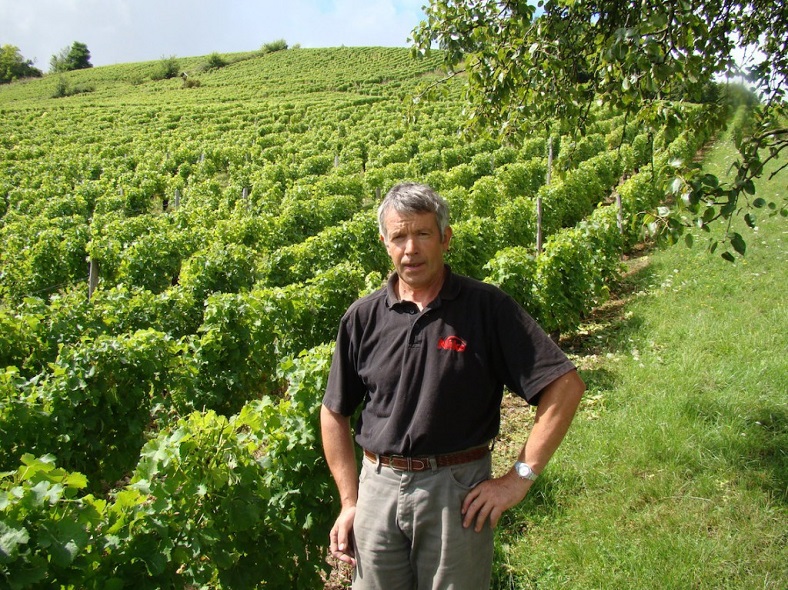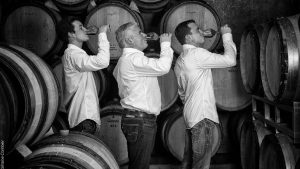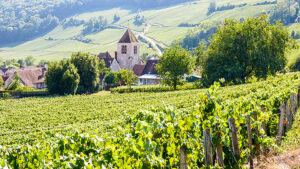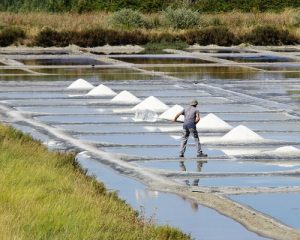
Discretely, since the beginning of the 2000s, Gérard Boulay has sat comfortably with the elite of Sancerre’s winemaking industry, among Cotat, Vatan and Vacheron. His pure, crystalline wines, capable of lengthy ageing, elegantly reflect the identity of their terroir.
‘Making wine since 1310’ proudly proclaims a sign in the tasting area at the entrance to Chavignol. Inheritor, therefore, of a long tradition – his grandfather, André, was President of the Viticultural Union when the appellation was created – Gérard Boulay is at the head of a domain that covers 11.5 hectares of vines, half owned and half rented. 2 hectares are for the red and rosé wines, the rest being dedicated to the production of white cuvées. The basic Sancerre wine makes up two thirds of the production here, though it’s a particularly attentive entry-level, at the heart of which Gérard Boulay is integrating young vines from classed terroirs.
Boulay is one of the rare winemakers in this appellation who has opted for organic production, achieved through careful work on the soil. This work takes place in Clos de Beaujeu, Monts Damnés and Grande Côte, his most beautiful plots, with the help of a little tractor called a chenillette for the most difficult slopes.
Gérard Boulay owns a good portion of Clos de Beaujeu which, for many wine enthusiasts, is undoubtedly Sancerre’s most beautiful terroir. This is a very steep plot, little more than a hectare in size, where the soils are composed of Kimmeridgian clay and chalk (much like Chablis terroirs), found rarely in Sancerre. The plot was defined and cleared by the monks of Beaujeu in the Middle Ages for the canon of Saint-Etienne de Bourges cathedral. For a long time, these were the only Sancerre vines used to produce white wine, and this remained the case until the phylloxera outbreak.
Grass is allowed to grow between vines in order to prevent erosion. For the ‘crus’, harvests are carried out by hand, whilst on other terroirs, much of the harvesting is done using machines. Treatments in the vineyard are as light as possible, with no pesticides, chemical additives, or anti-mould agents. The domain uses some organic compost.
The wines are vinified in the same spirit. The idea is to express the identity of the terroir rather than characteristics of the grape varieties, as enthusiastic as Boulay is about them. The yeasts are indigenous, racking is carried out at the end of fermentation and sulphur is added in homeopathic doses. Boulay doesn’t seem to be a great fan of wines overly marked by their élevage. The wine is matured in 300-litre barrels or in steel vats. As for the single-parcel wines, they are fermented in used barrels before maturing for a year on fine lees (without stirring in order to avoid milky aromas), as well as a final maturation in vats to bring an ‘airy’ texture. The Tradition cuvée is bottled at the beginning of May in 3 or 4 rounds, and the single-parcel cuvées are bottled in one go, in July or September depending on the vintage. The brand new winery just a few hundred metres from the entrance to Chavignol is absolutely superb, allowing for even more precise work on all of the wines.
What should be remembered about Gérard Boulay is his laudable discretion. Working relentlessly, he gave us the chance to taste his perfectly balanced wines, that are at once chewy, sapid, delicate, and energetic. As for the reds, we could praise their elegance for days…
Domaine Gérard Boulay, what do the guides say?
Guide Vert de La Revue du vin de France 2*/3
In Chavignol, the Boulay family have one of the most beautiful terroirs in the village, the Clos de Beaujeu. This plot, on a 70% incline, is in the Culs de Beaujeu area, facing the east/south-east, whilst the Mont Damnés plot that shares the same chalky soil is fully exposed to the south. This elevated exposure brings a rare elegance and refinement to the Sauvignon grapes, which will only fully express themselves after five years. After twenty years, they’ll evolve to carry the scent of white truffle. The wines are full and generous with an exemplary concentration for ageing, especially the pure Comtesse and the admirable red Oriane, capable to be aged for over 20 years in order to fully flourish.
The wines: the tasting level gets off to a strong start with the 2018 white Sancerre, an energetic Sauvignon that is well-made and will evolve nicely. The lieux-dits cuvées reach an impressive equilibrium with a rare density, translating the richness of the 2017 vintage. They are perfectly sound and sleek. These wines will intensify over time, particularly La Côte and Comtesse (from the foot of the Mont Damnés slopes): fine whites to be aged in the cellar. They’ll develop a Chablis-esque character over time. The red Oriane is original: an infusion of peppery flavours, it has a wonderful finesse about it.
Guide Bettane & Desseauve – 3*/5
The 12 hectares of vines kept reflect the rigour of Gérard Boulay, a seasoned wine maker who shines the light of this appellation across the world. Regular work on the soil, grasses growing on the most sloped plots to limit erosion, banning of pesticides and copper, manual removal of extra buds in order to avoid green harvests and limit yields, all of this is put into place to give an overall image of model agriculture. From ‘white land’, these Chavignol terroirs are made up of Kimmeridgian marl, identical to the Chablis soils. These are wines with lovely texture that each reflect their terroirs of Mont Damnés, Beaujeu, La Côte, and La Comtesse. The vast majority of this domain’s production is white, with the 2 hectares of red being almost entirely dedicated to rosé to be exported.
Gérard Boulay’s wines for sale at iDealwine
Sancerre Comtesse
The first vintage of this single-parcel cuvée from the Monts Damnés terroir was crafted in 2005. La Comtesse is made from old vines. A wine that deserves at least a five-year wait in order to reveal all its complexity and potential. Its nose is aromatic, with herbaceous and floral notes lifted by citrus aromas. The palate is ripe in roundness with a weak acidity. The finish is marked by a light bitterness.
Sancerre Oriane
The Oriane cuvée first came into being in 2012, and carries the same name as Gérard Boulay’s granddaughter, born in the same year. It is a blend of two plots, the Cheneau slope (opposite Clos de Beaujeu) and Graveron (adjoining Monts Damnés). The grapes are totally destemmed and the vinification is carried out with indigenous yeasts. The maturation takes place in barrels, without added sulphur, and half in new wood. The wine has aromas of red fruit (cherry, currant, strawberry) as well as notes of liquorice.
Sancerre La Côte
This cuvée has been made since 2010. It comes from a sub-parcel of Chavignol’s Grande Côte, where the vines are rooted in Kimmeridgian marl. A vibrant, savoury wine with smoky and spicy aromas. A white wine with great purity.
Sancerre Clos de Beaujeu
A brilliant yellow colour, this wine has a nose of exotic fruit whilst the palate is especially pure with a lovely mouthfeel and a fresh, mineral finish.
Sancerre Les Monts Damnés
Les Monts Damnés is one of Sancerre’s finest terroirs, located in the north of the appellation on a steeply inclined slope facing the south. This cuvée is matured in used barrels for 12 months on fine lees without stirring, then in vats. On the nose, it expresses aromas of white fruit and mint, as well as a very subtly oakiness. The palate is particularly sound with a pleasant acidity, fruit flavours and salty notes.



